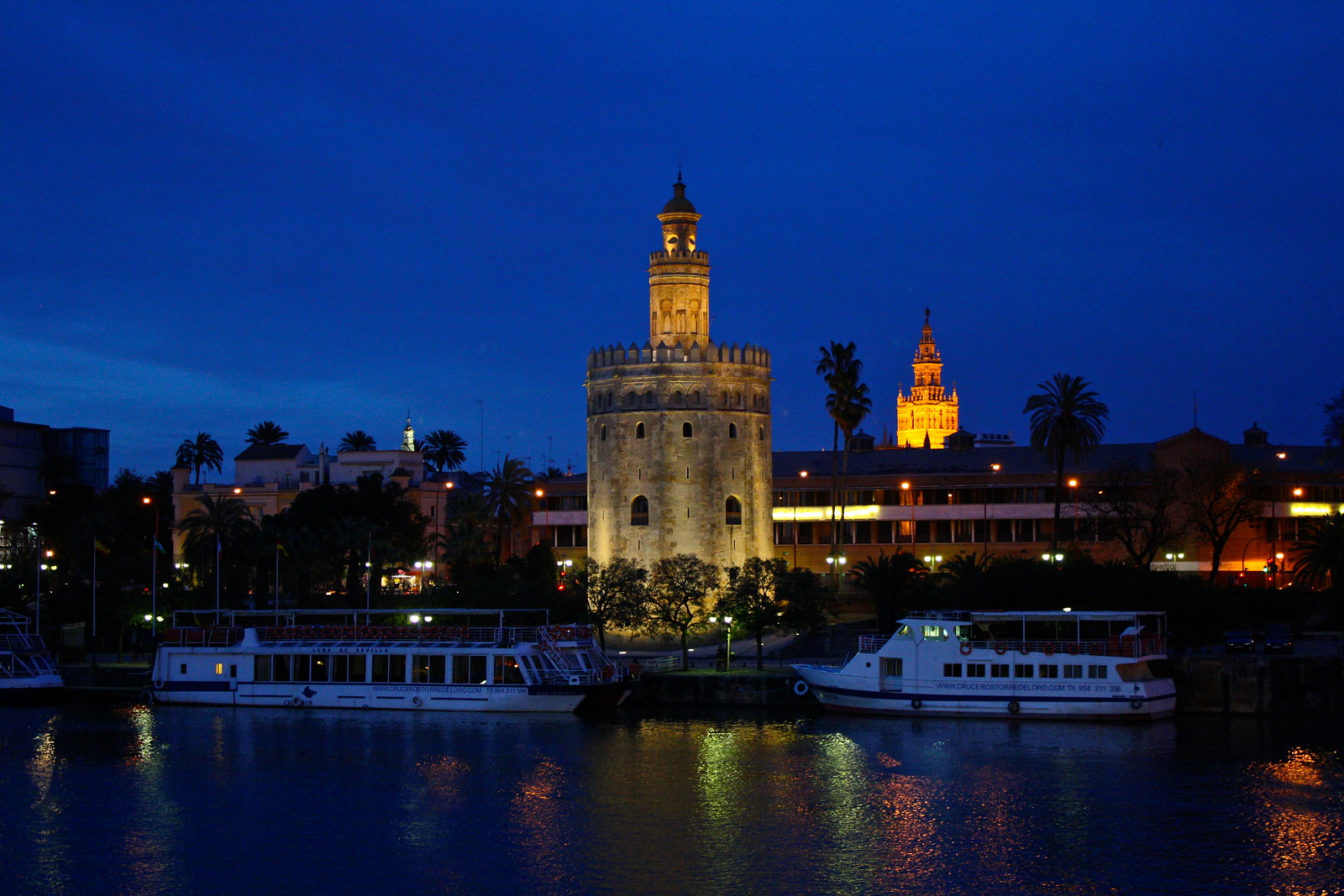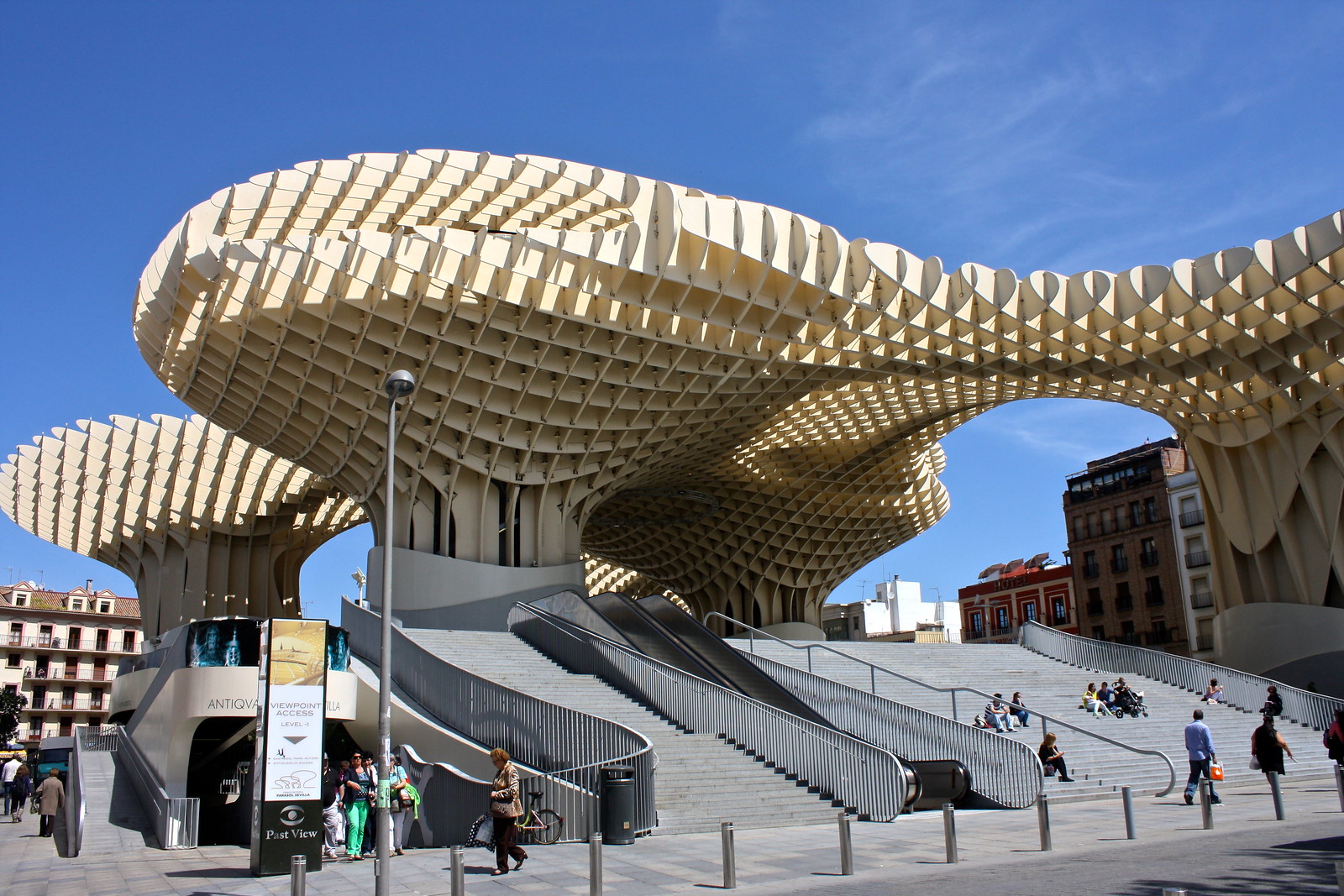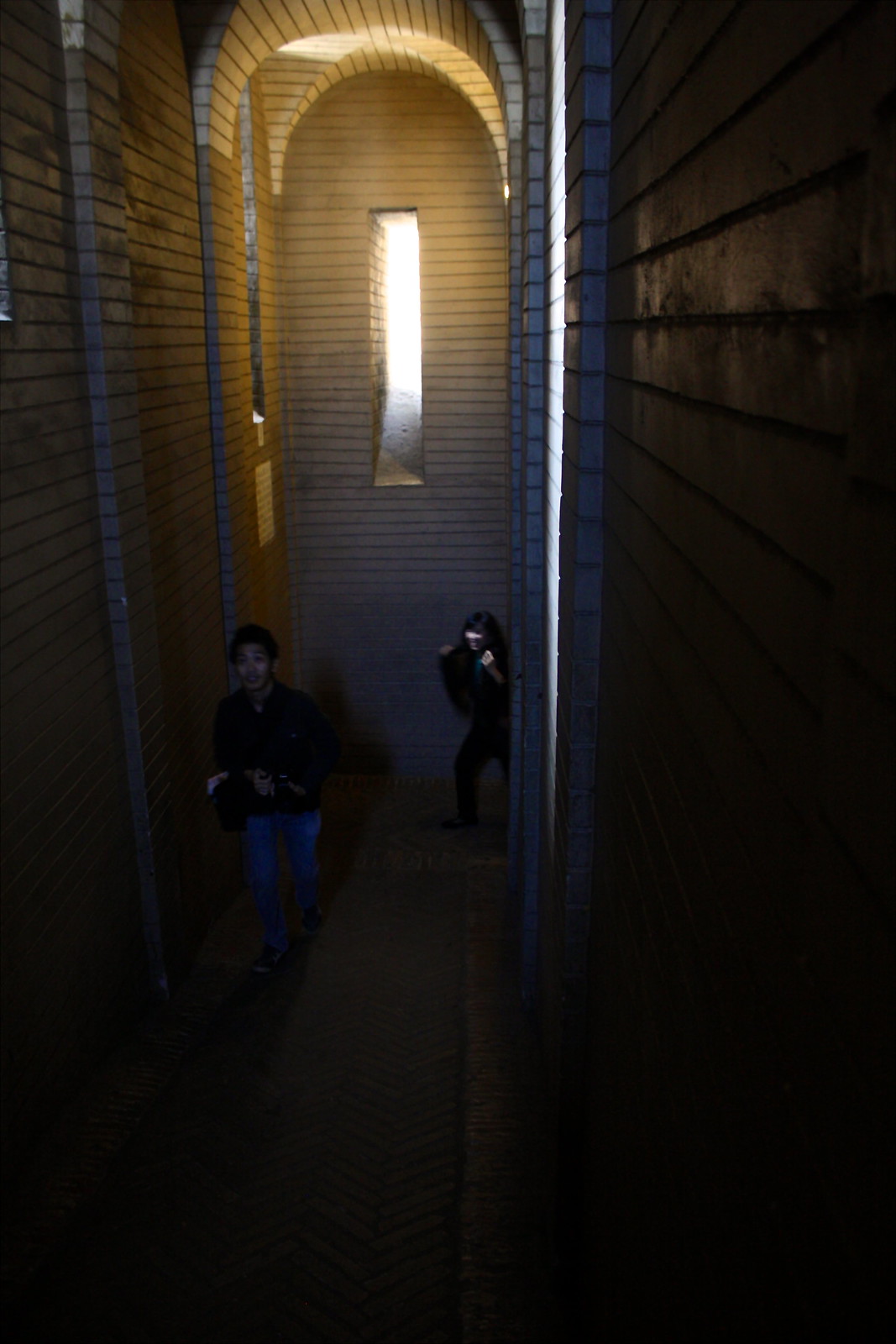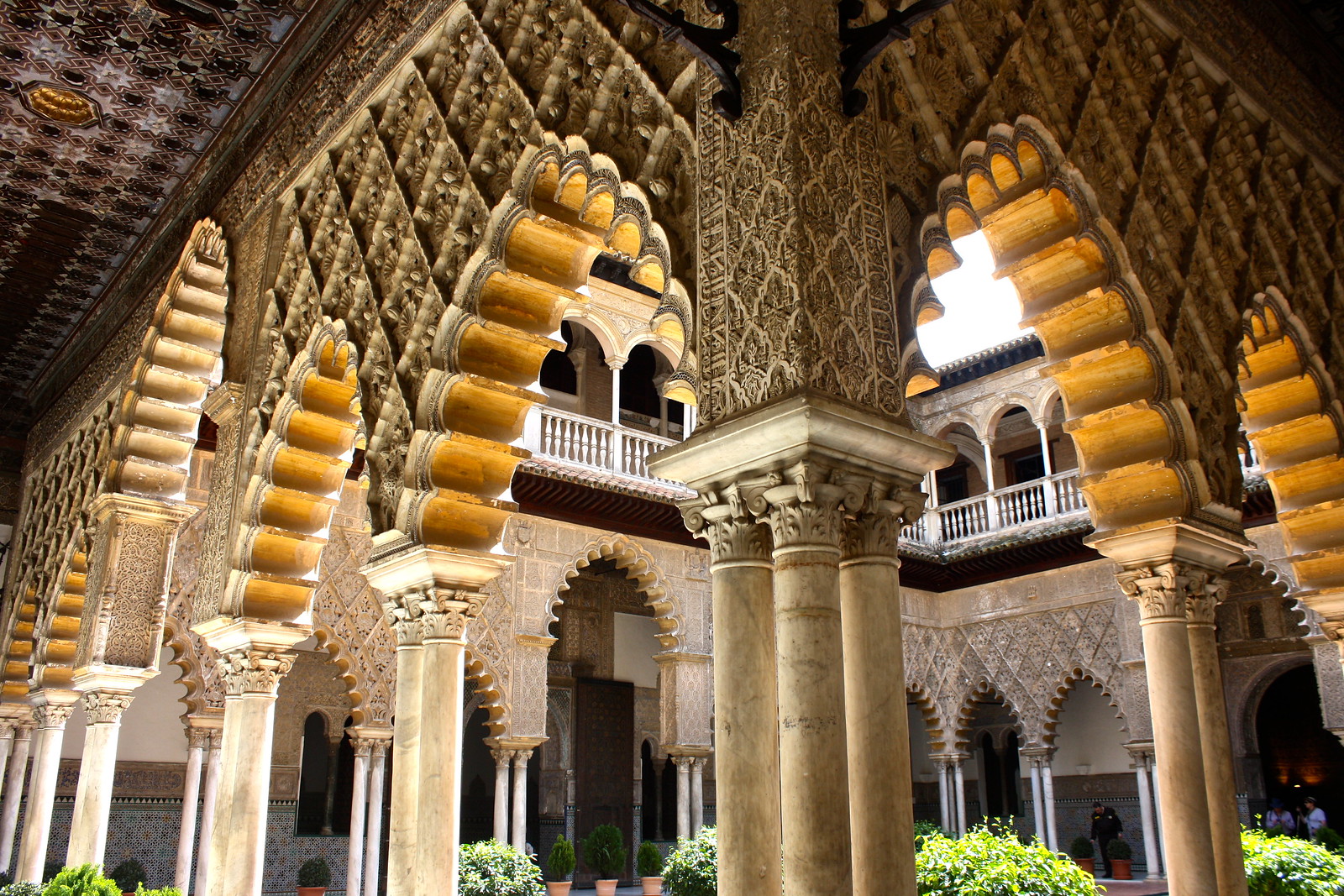Sevilla, Spain: The Heartbeat of Andalucía
I finally had the chance to visit Sevilla, the capital of Spain’s southern Andalucía region, in April of this year, and I don’t think I could have arrived at a better time: the springtime weather had made the city warm but not a frying pan, the long winter rain had finally let up, and a fragrant, floral air had invaded the streets and plazas.
Sevilla (pronounced “say-VEE-yah” [seˈβi.ʝa]) began as the Roman city of Hispalis, which served as a judicial capital within the province of Baetica. Over the centuries it continued to grow, and was an important city during Moorish times. When Columbus “discovered” the Americas, Sevilla discovered a monopoly on trade between Spain and the New World and subsequently became one of the richest cities in the world. The silting of the Guadalquivir River, however, effectively closed off its ports and pushed the center of trade south to Cádiz on the coast, and Sevilla foundered.
Its long decline began to reverse in the 20th century with two great fairs, first in 1929 with the Ibero-American Exposition—which brought together all American nations to Spain—and then with the Expo ’92—which celebrated the 500th anniversary of Columbus’s journey. One of the first destinations to come online Spain’s high-speed rail network, Sevilla is today a lovely Big City yet still retains its Andalusian charm.
And I think that’s what I love most about Sevilla: it’s the heartbeat of Andalucía and truly epitomizes the region’s distinct character, cuisine, and its past.
So much of Spain’s draw is (I hate this phrase) ancient history, and it’s always a pleasant surprise when something just plain cool is merely years old—yeah, the single digits. The Metropol Parasol in the Plaza de la Encarnación was finished in 2011 as a massive wooden structure embracing restaurants, shopping, and a museum. The six towers were modeled after the swooping trunks and branches of a ficus tree but to everybody else they look like setas or mushrooms. For a fee, you can ride an elevator to the top and wander around the wavy, panoramic lookout points from the center of town.
Sevilla’s Cathedral has got to be one of Spain’s top five cathedrals. On its own, it’s the world’s biggest cathedral built in the Gothic style (despite being built in the height of the Renaissance), and it’s still the third-largest church anywhere. Its interior space is frighteningly massive, even a bit gloomy. But what makes it special is how it integrates some of the old mosque it was built on top of.
After the capture of Moorish Ishbiliya by the Kingdom of Castilla in 1248, the city’s Great Mosque was quickly consecrated and became the local cathedral—think the Mosque-Cathedral of Córdoba but sans the Renaissance chapel. Mass went on swimmingly for a hundred years until the earthquake of 1356, which severely damaged the mosque structure. It was this seismic event that made the local authorities decide to raze the damaged naves of the old mosque and build what would become the largest church in the world at the time. However, they did conserve the Moorish Patio de los Naranjos (“Orange Tree Courtyard”) and Giralda, the gigantic minaret-turned-bell tower.
That same Giralda was originally built with 35 spiral ramps wide enough that Sevilla’s muezzin could ride up to the very top on horseback and call the city to prayer. It sure is a hike, but ascending the narrow passageways up to the top is a really satisfying experience as you get to see not only the whole city before you but also the cathedral and its fragrant courtyard. The Giralda’s Renaissance-era cap was added after multiple earthquakes damaged the upper terrace.
Three important Spaniards are buried here: Fernando III, the saint-king who conquered Sevilla from the Moors; his son Alfonso X, “the Wise,” who popularized Castilian in the royal court; and Christopher Columbus, who needs no further epithets.
The General Archive of the Indies (Archivo General de Indias) was a major letdown. Housed in a stately, square Renaissance building, it houses basically all documents and communications dealing with Spain’s overseas empire. I was looking forward to eyeing Columbus’s journals, gazing at reports written by Hernán Cortés, and old treaties, but all I got was a single exhibit about the Spanish War of Independence (a.k.a. the Peninsular War against Napoleon). Whomp whomp. At least it was free.
If Granada has its Alhambra, then Sevilla has its Alcázar. Deriving from the Arabic word for “palace,” the Royal Alcázar still functions today as a royal residence despite being open to the public. Since Moorish times, rulers have lived in the site of the present-day Alcázar, but it wasn’t until the “Christian” era that most of what we see today was constructed. So, although the Alhambra was designed by Moorish craftsmen in Islamic art patterns, the Alcázar (specifically the Palace of Pedro I) was actually conceived by Christians imitating those same Islamic forms. This Spaniards-imitating-the-Moors style was called mudéjar, and we should recognize the Alcázar as the finest example of that trend.
The whole complex is a truly dazzling ensemble of rooms and halls that flow from intricate plasterwork to tiles to woodwork and to arches. If you get overwhelmed by all the wondrous wall-to-wall, ceiling-to-the-floor beauty, you can step outside to the south and emerge in a well-curated set of gardens, flower beds, and sleepy trees. If you’re lucky, you may even run into a peacock or two like I did!
María Luisa Park was once the royal gardens belonging to the San Telmo Palace, and after it was given to the city, it was reconfigured to resemble a more Moorish paradise. Today, it’s the best place to go for an afternoon stroll or paseo, since really tall trees give you plenty of shade. Joggers gofooting running and lovers go kissing; grandmas lock arms while grandpas rock their berets. The park is a relaxing respite from the sometimes-intense magnificence of Sevilla’s historic core.
Plaza de España was the largest structure built for the exposition, housing its main offices. A vast semicircle built in the Renaissance Revival style, the “Spain Square” contains numerous alcoves built into the walls that celebrate each of the country’s provinces. Each alcove was decorated with tiles depicting famous events in the province’s history, important monuments, as well as a map with major cities. I couldn’t resist getting my picture taken in front of the alcove for Jaén, the province where I lived and worked this past year.
Further to the southeast, you run into two museums facing each other. The Archaeological Museum of Sevilla is worth visiting, especially if you plan on taking a daytrip to the nearby ruins of Itálica—Spain’s first Roman settlement—as most of the artifacts, mosaics, statues, etc. from the site are displayed inside here.
Finally, even if you don’t end up stepping inside the Popular Arts and Customs Museum, take some time to appreciate its exterior architecture. It was built in the Mudéjar Revival style, and thus reflects that movement’s penchant for grand Moorish horseshoe arches and geometric designs. The actual exhibits within were rather dated and boring, although I was really amazed by the room dedicated to handmade lacework and mantillas (traditional women’s headwear).
Amateur photographer that I am, I had in mind this shot of the Torre del Oro at night with the Giralda in the background, so I knew I’d have to go across the Guadalquivir River at some point. On the western bank, I waited for about an hour for the sun to go down until the exact moment when the sky went this deep cobalt blue. I got the photo I wanted (see the first pic of this post), but as I walked back across the San Telmo bridge, this beautiful composition appeared and I couldn’t resist taking another shot.
Something few travels writers ever talk about is the smell of the place. But in spring in Sevilla, it would be a crime not to mention the olfactory beauty that is the orange blossom. When I first heard about the azahar, I thought it would be no big deal, just a nice little springtime flower.
Until I smelled it—and I swooned. Dear Lord, that heavenly fragrance of the orange blossom is quite possibly the most wonderful aroma in the world: a pleasant, addictive cross between magnolia and wisteria. The tender, delicate scent was so lovely that I literally went out of my way to walk beneath orange trees in the street…and I lingered for half an hour in the cathedral’s Patio de los Naranjos just soaking in the smell. If you come to Sevilla in April, expect a perfumed city!
A few weeks before I came to Sevilla, veteran language assistant and prominent expat-in-Spain blogger Cat Gaa of Sunshine and Siestas invited me via Twitter to get together for a tapa or two in her adopted hometown. I’ve always enjoyed reading her experiences teaching, traveling, and dating a Spaniard on her blog so, naturally, I agreed! She was kind enough to include me in a birthday picnic she was helping organize for one of her American friends in the city. It was fun getting to meet new people, both Spanish and expat, and I enjoyed the relaxing atmosphere of the decidedly non-touristy Alamillo Park to the northeast of town. Thanks so much for letting me hang out with y’all, Cat!
What’s your opinion of Sevilla? Too touristy or the azahar of Andalucía? Add your voice to the discussion below!

 |
| Torre del Oro (foreground) and the Giralda (background) at the blue hour |
Sevilla (pronounced “say-VEE-yah” [seˈβi.ʝa]) began as the Roman city of Hispalis, which served as a judicial capital within the province of Baetica. Over the centuries it continued to grow, and was an important city during Moorish times. When Columbus “discovered” the Americas, Sevilla discovered a monopoly on trade between Spain and the New World and subsequently became one of the richest cities in the world. The silting of the Guadalquivir River, however, effectively closed off its ports and pushed the center of trade south to Cádiz on the coast, and Sevilla foundered.
Its long decline began to reverse in the 20th century with two great fairs, first in 1929 with the Ibero-American Exposition—which brought together all American nations to Spain—and then with the Expo ’92—which celebrated the 500th anniversary of Columbus’s journey. One of the first destinations to come online Spain’s high-speed rail network, Sevilla is today a lovely Big City yet still retains its Andalusian charm.
And I think that’s what I love most about Sevilla: it’s the heartbeat of Andalucía and truly epitomizes the region’s distinct character, cuisine, and its past.
The lookout point: Las Setas
 |
| Las Setas |
So much of Spain’s draw is (I hate this phrase) ancient history, and it’s always a pleasant surprise when something just plain cool is merely years old—yeah, the single digits. The Metropol Parasol in the Plaza de la Encarnación was finished in 2011 as a massive wooden structure embracing restaurants, shopping, and a museum. The six towers were modeled after the swooping trunks and branches of a ficus tree but to everybody else they look like setas or mushrooms. For a fee, you can ride an elevator to the top and wander around the wavy, panoramic lookout points from the center of town.
The big monuments: Plaza del Triunfo
The historic downtown area of Sevilla has been declared a World Heritage Site by UNESCO, and all three of the main buildings on that list can be found in the downtown Plaza del Triunfo, or “Triumph Square.” |
| Sevilla Cathedral |
Sevilla’s Cathedral has got to be one of Spain’s top five cathedrals. On its own, it’s the world’s biggest cathedral built in the Gothic style (despite being built in the height of the Renaissance), and it’s still the third-largest church anywhere. Its interior space is frighteningly massive, even a bit gloomy. But what makes it special is how it integrates some of the old mosque it was built on top of.
 |
| Going up the spiral ramp-case |
After the capture of Moorish Ishbiliya by the Kingdom of Castilla in 1248, the city’s Great Mosque was quickly consecrated and became the local cathedral—think the Mosque-Cathedral of Córdoba but sans the Renaissance chapel. Mass went on swimmingly for a hundred years until the earthquake of 1356, which severely damaged the mosque structure. It was this seismic event that made the local authorities decide to raze the damaged naves of the old mosque and build what would become the largest church in the world at the time. However, they did conserve the Moorish Patio de los Naranjos (“Orange Tree Courtyard”) and Giralda, the gigantic minaret-turned-bell tower.
That same Giralda was originally built with 35 spiral ramps wide enough that Sevilla’s muezzin could ride up to the very top on horseback and call the city to prayer. It sure is a hike, but ascending the narrow passageways up to the top is a really satisfying experience as you get to see not only the whole city before you but also the cathedral and its fragrant courtyard. The Giralda’s Renaissance-era cap was added after multiple earthquakes damaged the upper terrace.
Three important Spaniards are buried here: Fernando III, the saint-king who conquered Sevilla from the Moors; his son Alfonso X, “the Wise,” who popularized Castilian in the royal court; and Christopher Columbus, who needs no further epithets.
The General Archive of the Indies (Archivo General de Indias) was a major letdown. Housed in a stately, square Renaissance building, it houses basically all documents and communications dealing with Spain’s overseas empire. I was looking forward to eyeing Columbus’s journals, gazing at reports written by Hernán Cortés, and old treaties, but all I got was a single exhibit about the Spanish War of Independence (a.k.a. the Peninsular War against Napoleon). Whomp whomp. At least it was free.
 |
| Royal Alcázar of Sevilla |
If Granada has its Alhambra, then Sevilla has its Alcázar. Deriving from the Arabic word for “palace,” the Royal Alcázar still functions today as a royal residence despite being open to the public. Since Moorish times, rulers have lived in the site of the present-day Alcázar, but it wasn’t until the “Christian” era that most of what we see today was constructed. So, although the Alhambra was designed by Moorish craftsmen in Islamic art patterns, the Alcázar (specifically the Palace of Pedro I) was actually conceived by Christians imitating those same Islamic forms. This Spaniards-imitating-the-Moors style was called mudéjar, and we should recognize the Alcázar as the finest example of that trend.
The whole complex is a truly dazzling ensemble of rooms and halls that flow from intricate plasterwork to tiles to woodwork and to arches. If you get overwhelmed by all the wondrous wall-to-wall, ceiling-to-the-floor beauty, you can step outside to the south and emerge in a well-curated set of gardens, flower beds, and sleepy trees. If you’re lucky, you may even run into a peacock or two like I did!
The green spaces: María Luisa Park
In preparation for the 1929 Ibero-American Exposition, Sevilla moved heaven and earth (mainly earth) to prepare for dozens of country pavilions and inevitable crowds of tourists. To the southeast, the city already boasted a substantial city park, donated by and named for the infanta (princess) María Luisa Fernanda, and it was in this park and its surroundings that they constructed the exhibition buildings. |
| María Luisa Park |
María Luisa Park was once the royal gardens belonging to the San Telmo Palace, and after it was given to the city, it was reconfigured to resemble a more Moorish paradise. Today, it’s the best place to go for an afternoon stroll or paseo, since really tall trees give you plenty of shade. Joggers go
Plaza de España was the largest structure built for the exposition, housing its main offices. A vast semicircle built in the Renaissance Revival style, the “Spain Square” contains numerous alcoves built into the walls that celebrate each of the country’s provinces. Each alcove was decorated with tiles depicting famous events in the province’s history, important monuments, as well as a map with major cities. I couldn’t resist getting my picture taken in front of the alcove for Jaén, the province where I lived and worked this past year.
 |
| Plaza de España |
Further to the southeast, you run into two museums facing each other. The Archaeological Museum of Sevilla is worth visiting, especially if you plan on taking a daytrip to the nearby ruins of Itálica—Spain’s first Roman settlement—as most of the artifacts, mosaics, statues, etc. from the site are displayed inside here.
Finally, even if you don’t end up stepping inside the Popular Arts and Customs Museum, take some time to appreciate its exterior architecture. It was built in the Mudéjar Revival style, and thus reflects that movement’s penchant for grand Moorish horseshoe arches and geometric designs. The actual exhibits within were rather dated and boring, although I was really amazed by the room dedicated to handmade lacework and mantillas (traditional women’s headwear).
The perfect sunset shot: Guadalquivir River
 |
| The Guadalquivir River and the Torre del Oro at the blue hour |
Amateur photographer that I am, I had in mind this shot of the Torre del Oro at night with the Giralda in the background, so I knew I’d have to go across the Guadalquivir River at some point. On the western bank, I waited for about an hour for the sun to go down until the exact moment when the sky went this deep cobalt blue. I got the photo I wanted (see the first pic of this post), but as I walked back across the San Telmo bridge, this beautiful composition appeared and I couldn’t resist taking another shot.
The aroma of spring: the orange blossom
 |
| The azahar or orange blossom |
Something few travels writers ever talk about is the smell of the place. But in spring in Sevilla, it would be a crime not to mention the olfactory beauty that is the orange blossom. When I first heard about the azahar, I thought it would be no big deal, just a nice little springtime flower.
Until I smelled it—and I swooned. Dear Lord, that heavenly fragrance of the orange blossom is quite possibly the most wonderful aroma in the world: a pleasant, addictive cross between magnolia and wisteria. The tender, delicate scent was so lovely that I literally went out of my way to walk beneath orange trees in the street…and I lingered for half an hour in the cathedral’s Patio de los Naranjos just soaking in the smell. If you come to Sevilla in April, expect a perfumed city!
The expat meet-up: with Cat of Sunshine and Siestas
 |
| Gratuitous Royal Alcázar photo because I forgot to take pictures at the park |
A few weeks before I came to Sevilla, veteran language assistant and prominent expat-in-Spain blogger Cat Gaa of Sunshine and Siestas invited me via Twitter to get together for a tapa or two in her adopted hometown. I’ve always enjoyed reading her experiences teaching, traveling, and dating a Spaniard on her blog so, naturally, I agreed! She was kind enough to include me in a birthday picnic she was helping organize for one of her American friends in the city. It was fun getting to meet new people, both Spanish and expat, and I enjoyed the relaxing atmosphere of the decidedly non-touristy Alamillo Park to the northeast of town. Thanks so much for letting me hang out with y’all, Cat!
What’s your opinion of Sevilla? Too touristy or the azahar of Andalucía? Add your voice to the discussion below!
